Log in or create new account to save this product to your wishlist.

Snails in the garden: how to get rid of them
Snails can destroy your veg patch in less than a week. But before you rush for the chemical killers, find out the natural approaches to controlling these hungry molluscs.
🌱 All important maintenance moments for your lawn during the year. Leave your email and we will send you the lawn calendar for free.
Enter your email
Receive the lawn calendar in the mail
Enjoy a green lawn all year round!

- Order by 2PM = shipped today
- 250.000+ satisfied customers!
- 60 day satisfaction guarantee
Do your plants thrive, then suddenly die off? Have you noticed little slime trails across your soil? It sounds like you’ve got snails in your garden.
- What are snails?
- The Role of Snails in the Garden
- Identifying Snails in the Garden
- Why Snails are a Problem in the Garden
- Natural Ways to Get Rid of Snails
- Conclusion
- FAQs
- Any questions?
Snails are a common pest in the garden, and getting rid of them can be challenging. And while some gardeners decide to use chemical pesticides to control the infestation, there are several natural approaches to controlling snails which are safer and more sustainable.
This article will explore the various ways of effectively eliminating snails in the garden and maintaining a healthy and pest-free environment.
What are snails?
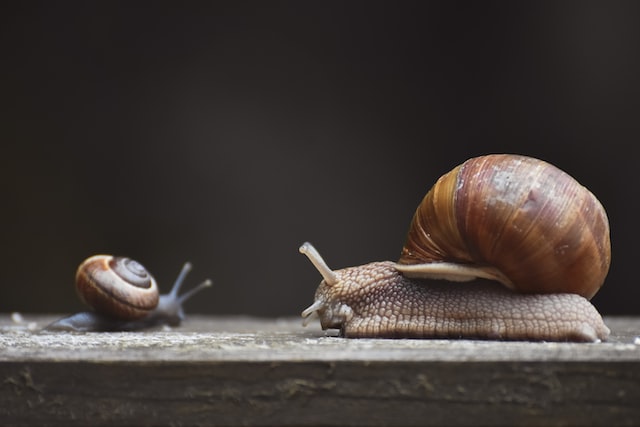
Snails are small, slimy molluscs with a soft, muscular foot, which they use to move around your garden, leaving a slimy trail in their wake. They’re usually brown, grey, or black and leave a slimy, mucous-like trail as they move. They range in size from tiny slugs to large, globe-shaped snails.
Snails have a hard, protective shell they can retreat into if they feel threatened. They feed on various plants and can be found in many environments, from deserts to forests to domestic gardens.
Snails are hermaphroditic – this means they have both male and female reproductive organs and can reproduce without a mate. This makes them very difficult to control, and why snail infestations occur and spread rapidly.
The Role of Snails in the Garden
Snails play an essential role in maintaining the balance of the garden ecosystem. They feed on decaying plant matter, helping to keep the soil healthy and full of nutrients.
They also provide food for other animals, such as birds, amphibians, and other beneficial insects. In addition, snails help to aerate the soil, which assists with water drainage and allows air and water to reach plant roots more easily.
Benefits of snails in the ecosystem
Snails provide many benefits to the ecosystem. They help to maintain soil structure and fertility by feeding on decaying organic material and humus, which helps to keep the soil full of nutrients.
They provide food for other species, such as birds and frogs, and help control the population of other organisms, such as insects and weeds, which helps keep the ecosystem in balance.
Drawbacks of snails in the garden
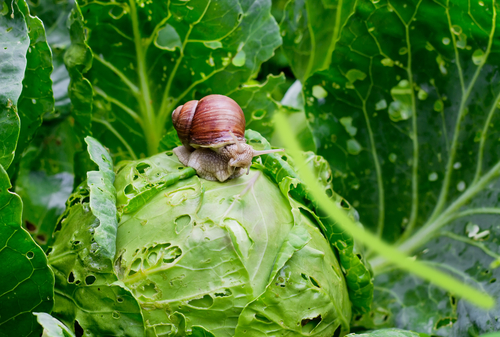
The main drawback to having snails in the garden is that they cause damage to plants by eating their leaves and stems.
They feed on garden vegetables, fruits, and flowers. They’ll also eat the leaves of trees and shrubs, leaving them wilted and unhealthy. Snails can even eat tree bark, leaving the tree vulnerable to disease and insect infestations.
Finally, they can carry parasites and diseases that harm humans, plants and animals. If you’re handling snails, it’s essential to wear gloves and wash your hands afterwards.
Identifying Snails in the Garden
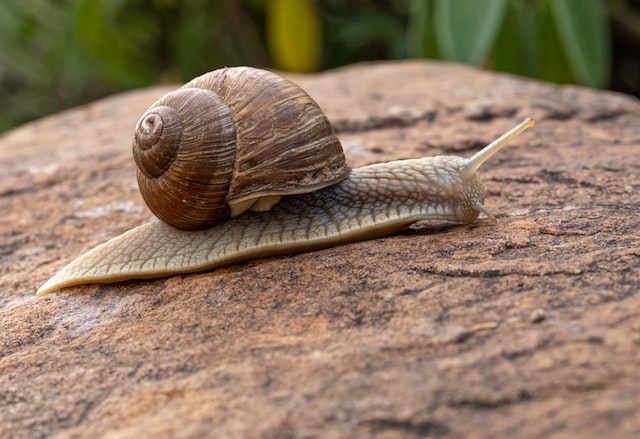
You can identify snails in the garden by their shells, which are usually spiral-shaped and can be seen on the ground or on plants.
They leave behind slime trails, and their presence can also be identified by feeding marks on the leaves and stems of plants.
You can also identify a snail infestation by looking for eggs – usually found near the base of plants or in damp areas near the soil.
What are the physical characteristics of snails?
Snails have soft, slimy bodies and two pairs of tentacles; one pair for sensing and orientating and the other for movement. They have large, spiral-shaped shells, which protect their bodies, and a large foot – used to crawl along the ground.
They also have a mucous-filled lung that helps them breathe and stay moist and a rasping tongue-like organ called a radula, used for feeding.
Different species of snails commonly found in gardens
There are many different species of snails commonly found in UK gardens, including:
- Garden snail (Helix aspersa)
- Brown garden snail (Cornu aspersum)
- Yellow garden snail (Cepaea hortensis)
- White garden snail (Cantareus aspersus)
- Black garden snail (Theba pisana)
- Banded snail (Cepaea nemoralis), and
- Striped snail (Cepaea vittata).
Additionally, some non-native species, such as the invasive Giant African Snail (Achatina fulica), can also be found in UK gardens.
Why Snails are a Problem in the Garden
Snails in the garden are a problem because they feed on and damage various plants. They spread diseases and parasites and contaminate food crops with their slime trail.
Additionally, they can reproduce rapidly, making it difficult to control their population numbers.
How snails damage plants and gardens
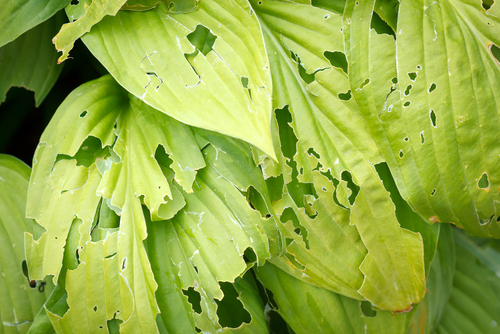
Snails damage plants and gardens by feeding on and eating leaves, flowers, stems, and fruits. They can also chew through roots and damage seedlings.
In addition, they can spread diseases and parasites, which can further damage plants.
Snails as carriers of plant diseases
Snails can carry plant diseases such as powdery mildew, downy mildew, verticillium wilt, and various fungal and bacterial infections.
They can spread these diseases by feeding on the infected plants or passing them through their slime trail when they move. These diseases can cause significant damage to plants and can even ruin entire crops.
But snails can be harmful to humans, spreading a range of parasitic diseases, such as angiostrongylus cantonensis (also known by the disgusting name Rat lungworm disease), which can cause meningitis.
So, wash your hands after handling snails in the garden!
Snails as a food source for other wildlife
Snails can be a food source for wildlife, such as birds, toads, frogs, hedgehogs, slowworms, and ground beetles. Of course, most of these are beneficial garden visitors, and we should encourage their presence to help protect our local wildlife population.
However, it’s important to remember that some snail predators, such as beetles, can also cause damage to plants, so it’s essential to assess the situation before introducing them into the garden as a natural snail defence.
Natural Ways to Get Rid of Snails
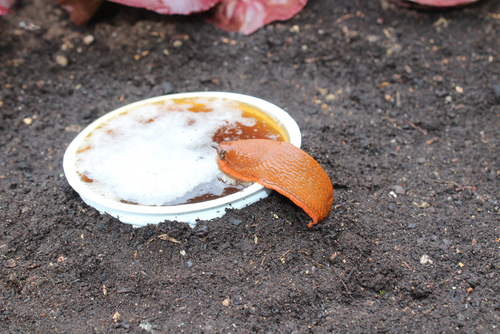
The good news is that there are plenty of natural ways to get rid of snails from your garden. Let’s look at some of the most effective methods.
Manual Removal of Snails from the Garden
The simplest way to remove snails is to remove them from your garden manually. This can be done by hand or with a trowel.
They’re more active at night, so use a flashlight to locate these hungry critters in the dark.
When removing them, avoid damaging your plants. This is especially important for delicate flowers and fruits.
Using Barriers to Prevent Snails from Entering the Garden
Another way to keep snails out of your garden is to use barriers.
These can be physical barriers, such as copper tape, or chemical barriers, such as diatomaceous earth.
Physical barriers create an electrical charge that the snails cannot cross. Chemical barriers create an abrasive surface that the snails cannot traverse.
Creating a Hostile Environment for Snails
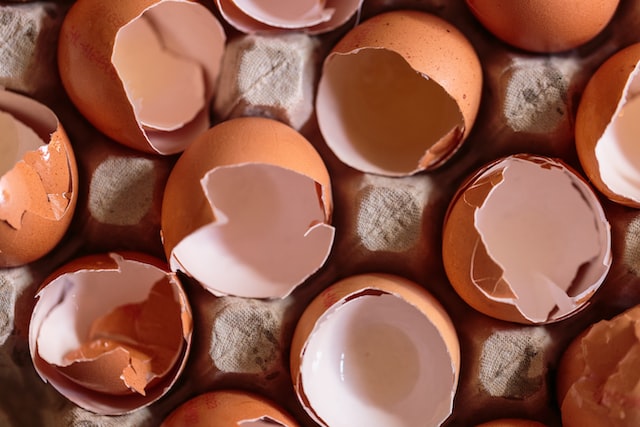
Another way to eliminate snails in the garden is to create a hostile environment for them. You can do this by removing potential hiding spots, such as rocks and logs, and by reducing the dampness in the garden.
You can also use sharp objects, such as crushed eggshells and sandpaper, to deter the snails. These objects will irritate the snails’ sensitive foot, causing them to leave the area in search of other food sources.
Alternatively, rake up fallen leaves from your lawn and flowerbeds in the autumn. This will reveal snails and slugs feeding on the organic matter, which will be a tasty treat for the birds.
Using Natural Predators to Get Rid of Snails
Several natural predators can help to keep the snail population in check. These include birds, frogs, and some species of fish.
Encouraging these creatures to visit your garden can help control the snail population. However, you should be aware that some predators may also eat other beneficial animals, such as bees and butterflies.
Introducing predators such as ducks, chickens, and geese to your garden can help to reduce the snail population. These animals will eat the snails, which will help control the population.
Using Chemical Methods to Get Rid of Snails
Another way to get rid of snails is to use chemical methods. The most common chemical for killing snails is metaldehyde, which is applied to the earth and is widely available commercially.
However, you should be aware that this chemical can be toxic to other creatures, such as pets and beneficial insects, so it should be used with caution. Remember, birds may still eat a poisoned slug or snail, so use chemicals sparingly.
Using Traps to Catch and Remove Snails
You can use traps to catch and remove snails from your garden.
These traps typically use bait, such as beer, to attract the snails. Fill an empty jam jar with a little beer; then half bury the jar. The snails will smell the beer, climb into the pot, and drown.
Once the snails enter the trap, they can be removed and discarded.
Conclusion
Snail infestations can be a real nuisance in the garden and cause significant damage to plants and foliage.
Thankfully, there are a variety of methods for controlling snails in the garden, from manual removal to using natural predators. By taking a multi-pronged approach, you can effectively prevent future snail infestations and keep your garden safe.
FAQs
The best way to remove snails from your garden is to make sure that it’s free of food sources, such as excess water, decaying vegetation, and other organic matter. Remove snails by hand or encourage natural predators like birds, chickens, ducks, and frogs. Chemical treatments can be used to kill snails but should be used as a last resort.
Snails can be beneficial to your garden in certain instances. They consume decaying plant matter, helping improve soil health and fertility. They also help aerate the soil and provide a food source for other animals such as birds, frogs, and hedgehogs.
Make sure your garden is free of snail food sources, such as puddles, decaying vegetation, and other organic matter. Trap slugs and snails with a beer trap or remove them by hand. Chickens and ducks will eat snails, as will frogs. Use chemicals as a last resort because you can poison other wildlife.
Any questions?
I hope you’ve got all the information you need about how to get rid of snails in the garden. But if you have questions, don’t hesitate to get in touch.
We’d love to hear from you, and we promise to reply promptly!
Thanks for reading.
-
How to Build a DIY Greenhouse: A Practical Guide for Smart SpendersImagine extending your growing season throughout the year, nurturing tender plants regardless of the weather, and creating a personal garden sanctuary. This is precisely what a DIY greenhouse offers you. Let’s learn how to build one.Read more
-
How to Grow Eucalyptus in British GardensWith a little love and care, eucalyptus trees can thrive in English gardens. Since they don’t germinate well without proper help, there are not considered invasive. So, there is no reason not to plant them if you enjoy their looks.Read more
-
Transform Your Garden with All-Year-Round Flowering PlantsDid you know you can enjoy blooming flowers even in January? With the right selection of all year round plants, there’s no need to wait until spring to add some colour to your garden.Read more
-
How to Create a Butterfly Garden: A Simple Guide for British GardensThe UK's butterfly population includes 59 different species. These beautiful winged creatures face a steady decline because of habitat loss, pollution and changing weather patterns. Your garden can become a vital link between nature reserves and natural habitats. Let’s explore how.Read more
-
Volcanic Rock Dust for Your Garden—Application and TipsDid you know that volcanic rock dust is a brilliant organic soil improver? This article explains exactly what it's good for and how to use it properly.Read more
-
How to Use Landscape Fabric ProperlyIf weeds or erosion in your garden are troubling you, landscape fabric might be the solution. We’ll explain how and when to use it properly, just keep on reading.Read more
-
Hostas: A Complete Care GuideIf you have a north-facing garden or some shady corners on your property, hostas are the plants for you. These green delights thrive particularly well in partial to full shade and require consistently moist soil to perform at their best.Read more
-
How to Grow Grapes in Your Garden: A Simple Step-by-Step GuideGrapevines produce some tasty fruits, but often they are simply grown for their gorgeous leaves. Whatever your motivation may be, we have a guide on how to grow grapes for you.Read more
Leave a comment
Your answer will be displayed on the site and the interested party will be notified by email.
Leave a comment
Have a question or want to share your experience? Leave us a comment.

- Order by 2PM = shipped today
- 250.000+ satisfied customers!
- 60 day satisfaction guarantee

- Order by 2PM = shipped today
- 250.000+ satisfied customers!
- 60 day satisfaction guarantee

- Order by 2PM = shipped today
- 250.000+ satisfied customers!
- 60 day satisfaction guarantee

🌱 All important maintenance moments for your lawn during the year. Leave your email and we will send you the lawn calendar for free.
Enter your email
Receive the lawn calendar in the mail
Enjoy a green lawn all year round!





















Comments (0)
There are no comments yet. Well then, what are you waiting for to
Be the first to write your comment!inaugurate this pretty page?
Do you have some comments?